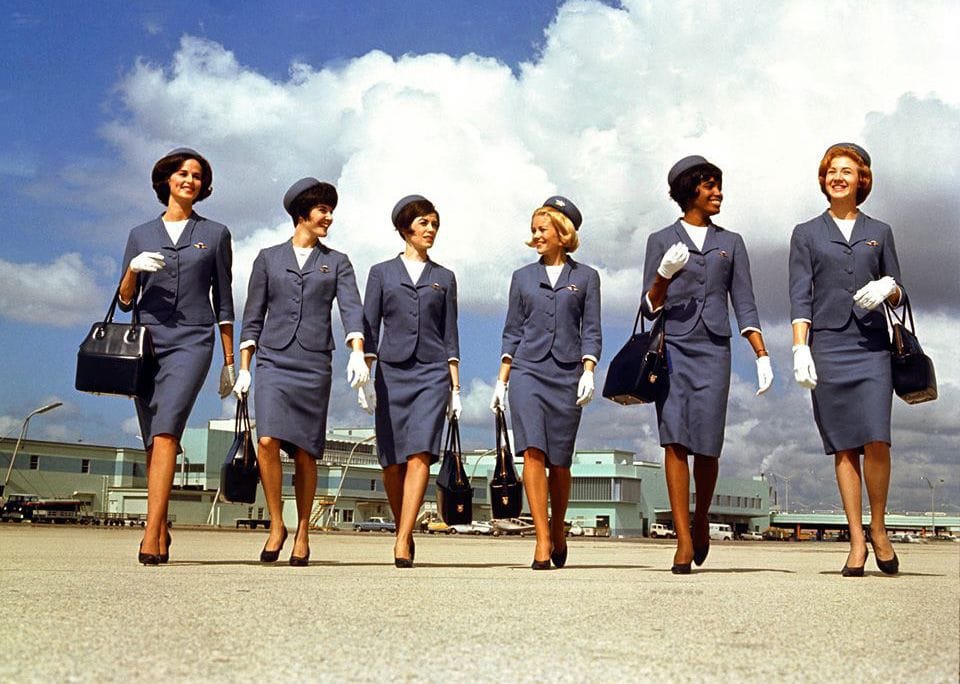Airline Uniforms: professional or passé?

While many industries are retiring dress codes or uniforms that force their female employees to conform to patriarchal beauty standards, a glaringly obvious exception can be found in airline uniforms for their flight attendants.
In the event of a water landing, are you hoping your flight attendant wears heels with the panicked crowd and inflatable slide? In the event of an attempted hijacking, are you hoping your flight attendant is wearing a pencil skirt? When you think about someone who is on long flights most days, do you think it’s fair she can’t wear compression socks due to pantyhose requirements? Let's hope the answer to those questions is "no."
While there is variety in what airlines mandate for uniforms, for most of the last 90 years, flight attendants have been mandated to show their legs through various skirt, hosiery, and heel requirements. The rest of the world has changed dramatically since the 1930s, but wanting to be eye level with a pretty young woman’s legs while being served coffee apparently hasn’t.
Don’t think the “sex appeal” of an air-bound domestic servant is really part of the equation? To help you boke in your mouth a little, here’s an article rating which airlines have the sexiest flight attendants. And surprise, surprise, it's the airline that offers "more coverage" in their uniform and requires bright lipstick, Emirates Airlines. Oddly enough, the scarf is a nod to their Muslim country of origin and the hijabs worn by many Muslim women there, but women who truly adhere to hijab dress codes are not allowed to be flight attendants for their airline. Virtue signaling, anyone?
When I think about the problems I see in these airlines' uniforms (upholding the male gaze, conflating women painting a face over their face with professionalism, etc.), the one that stands out to me the most is requiring heels.
Anytime you fly, you sit through a mandatory safety tutorial about the aircraft and what to do in emergencies. I always chuckle a little when I see the inflatable rafts that deploy from the emergency exits. Flight attendants, in most airlines, are still required to wear heels. Our leaders during this emergency water landing are wearing shoes that would not work during a stampede to the exits, and could seriously jeopardize multiple lives, including their own. Can you imagine the raft tearing? Or these poor women treading water with heels they're strapped into? Or breaking their ankles during the commotion? To be honest, it undermines the safety precautions for me when employees are forced to wear unsafe shoes.
This also screams "security theatre" when everyone is required to go through TSA because of the threats of plane hijacking and other forms of terrorism, but then airlines are dressing the flight attendants as professional eye candy rather than in outfits that could better handle these threats. No one should have to handle such risks, but it does seem inconsistent to make so many parts of air travel about unlikely risks, but then cling to patriarchal dress codes that would endanger their employees during those emergencies or unlikely risks.
Which brings me to likely risks: damage to women's health through these shoes. Five years ago, I was sitting in the first row facing the first class flight attendant and it was my first time noticing a flight attendant's feet. She was wearing 2 inch heels, and her poor feet were swollen. She was late-middle aged, wearing a wig as many black women do, and rubbing her calves. My heart ached for this woman, who has likely had her appearance policed her whole life. Black hair has often been discriminated against in school and work dress codes, and as of now, only 12 states have passed laws protecting this hair type from racial discrimination. The majority of black women report that they feel they need to use wigs or straighten their hair to be seen as more professional, and it is common to hear them talk about how they feel the need to dress better, wear more cosmetics, and try harder to be taken seriously (this can even extend to dressing up before going to the ER so they don't have to convince the doctor to take them or their pain seriously). For this particular flight attendant, her field has a strong history of both racial and gender discrimination.
This woman has likely endured all sorts of policing of her appearance, and I knew that she had swollen ankles and feet in order to look a certain way for those of us sitting in business class. While I would never wish or expect a woman to wear heels, I have explicitly heard older men who fly business class complain about how "the stewardesses aren't as attractive as they used to be!" If we're being honest, these companies' "images" are based on catering to men who fly business class and have come to expect pretty, petite, smiling, coiffed female employees to serve them.
A United Airlines flight attendant anonymously shared the current Employee appearance and uniform standards guidebook. Updated January 31, 2024, I was happy to see that the guidebook explicitly welcomes different hair textures, and gives different protective styling for black employees their due.

However, if I could implement only one change, I would like to change their shoe policy. Zero drop shoes are shoes that keep your heel level with your toes, so there is no heel. This is closer to walking barefoot, which believe it or not, is basically responsible for the advancement of homo sapiens. A little over 25% of our bones are in our two feet, and the specialized tendons and arch of our feet gives us an incredible advantage over other animals. Human bipedalism allowed for the development of civilization throughout the world. So the careful weight distribution of our feet has been tested over the whole timeline of our species. Any heel whatsoever alters our posture and forces our weight onto the forefoot. When we wear zero drop shoes, it allows our gait, bones, muscles, and tendons to do their magic.
High heels have all sorts of risks. They can cause blisters, corns, calluses, plantar fasciitis, bunions, hammertoe, shortened Achilles tendons, ankle sprains, knee pain, and lower back and hip pain. While heels have a few times and places, they are wholly unnecessary for serving refreshments or saving lives in a medical emergency, plane crash, or hijacking. United Airlines does allow for lower heels sometimes, but everyone is required to wear some kind of heeled shoe.



So what can we do?
We can create the social change by wearing foot-shaped shoes and flat footwear. There are professional options for wide-toed loafers! And we can even avoid those special-occasion shoes with sandals and flats that are formal but still respect the way our bodies were designed!
We can also contact airlines and send them suggestions for including zero-drop and wide-toed shoes as part of their uniforms. Here are some easy links for the most popular US airlines, but please look up whichever one is local or popular where you are!
Use your own language, but here's an example of what you might say:
Hello, my name is ___. I would like to suggest that cabin members' uniforms be updated to include professional footwear that is healthier and more practical. Shoes with a wider toe box and no heel are much safer. If I had a medical emergency on board, or if there were any kind of emergency with the plane, I'd feel much safer knowing the flight attendants weren't wearing heels. Brands like Zaqq, Be Lenka, and Anya's are making formal shoes with no heels. Please consider updating your uniform to improve the health of your employees and the safety of your customers in the event of an emergency. Thank you, ___
While we may not be able to have as much choice in airlines as in other industries, we can encourage change and advocate for employee welfare.
I'm glad for all the progress airlines have made in the last 90 years. There are more women both in the cabin and in the cockpit, as well as less restrictive uniforms. Flight attendants are no longer fired as soon as they get married. But the reason they're asking for any heels is because of a sense of professionalism conveyed to us. We can articulate that our idea of professionalism doesn't need to harm flight attendants' bodies.

